Abstract
The distribution of cocaine and the cocaine metabolite benzoylecgonine (BE) in brain and plasma of Sprague-Dawley rat dams and their near-term fetuses was assessed 0.5 and 2 h post-injection on gestational day 20 following chronic daily subcutaneous injections of 10, 20, or 40 mg/kg/3 ml cocaine hydrochloride beginning on gestational day 8. Plasma concentrations of cocaine reached in the dams were found to be in the range of, or to exceed, those reported in human cocaine users. Dose-related increases in plasma and brain levels of cocaine in the dams and the fetuses were observed, particularly at 2 h post-injection. Fetal concentrations of cocaine in brain and plasma were approximately 2–3-fold less than those of the dams, suggesting that the placenta may somewhat restrict cocaine entry into fetal circulation. Brain/plasma cocaine ratios, however, were generally equivalent in the dams and fetuses, suggesting that once cocaine enters the circulation, its affinity for brain tissue is similar in the fetus and dam. Whereas plasma levels of BE, like cocaine levels per se, were greater in the dams than fetuses, BE concentrations in fetal brain were greater than those observed in maternal brain. These high levels of BE may contribute to the production of neurobehavioral alterations in cocaine-exposed offspring, given that this active cocaine metabolite has been shown to form molecular complexes with calcium ions (Misra and Mule 1975), thereby having the potential to influence a multiplicity of calcium-regulated developmental events. Taken together, the results of the present study suggest that the subcutaneous route may prove to be an appropriate means in rats for administering cocaine prenatally in investigations designed to assess potential neurobehavioral ramifications of gestational cocaine exposure.
Similar content being viewed by others
References
Benuck M, Lajtha A, Reith ME (1987) Pharmacokinetics of systemically administered cocaine and locomotor stimulation in mice. J Pharmacol Exp Ther 243:144–149.
Chasnoff I, Burnes WJ, Schnoll SH, Burns KA (1985) Cocaine use in pregnancy. New Engl J Med 313:666–669.
Church MW, Dincheff BA, Gessner PK (1988) Dose-dependent consequences of cocaine on prenancy outcome in the Long-Evans rat. Neurotoxicol Teratol 10:51–58.
Dougherty J, Pickens R (1976) Pharmacokinetics of intravenous cocaine self-injection. In: Mule SJ (ed) Cocaine chemical biological, clinical, social and treatment aspects. CRC Press, Cleveland Ohio, pp 105–120.
Foss J, Riley EP (1988) Behavioral evaluation of animals exposed prenatally to cocaine. Teratology 37:517.
Javaid JI, Fischman MW, Schuster CR, Dekirmenjian H, Davis JM (1978) Cocaine plasma concentration: relation to physiological and subjective effects in humans. Science 202:227–228.
Kutscher CL, Nelson BK (1985) Dosing considerations in behavioral teratology testing. Neurobehav Toxicol Teratol 7:663–664.
Misra AL (1976) Disposition and biotransformation of cocaine. In: Mulé SJ (ed) Cocaine: chemical biological, clinical, social and treatment aspects. CRC Press, Cleveland Ohio, pp 73–90.
Misra AL, Mulé SJ (1975) Calcium-binding property of cocaine and some of its active metabolites: formation of molecular complexes. Res Commun Chem Pathol Pharmacol 11:663–666.
Misra AL, Nayak PK, Bloch R, Mulé SJ (1975) Estimation and disposition of [3H] benzoylecgonine and pharmacological activity of some cocaine metabolites. J Pharm Pharmacol 27:784–786.
Moore TR, Sorg J, Miller L, Key TC, Resnik R (1986) Hemodynamic effects of intravenous cocaine on the pregnant ewe and fetus. Am J Obstet Gynecol 155:883–888.
Mulé SJ, Misra AL (1977) Cocaine: distribution and metabolism in animals. In: Ellinwood EH Jr, Kilbey MM (eds) Cocaine and other stimulants. Plenum Press, New York, pp 215–228.
Nayak PK, Misra AL, Mulé SJ (1976) Physiological disposition and biotransformation of [3H]cocaine in acutely and chronically treated rats. J Pharmacol Exp Ther 196:556–569.
Pickens R, Thompson T (1968) Cocaine-reinforced behavior in rats: effects of reinforcement magnitude and fixed-ratio size. J Pharmacol Exp Ther 161:122–129.
Reinis S, Goldman JM (1980) The development of the brain: biological and functional perspectives. C.C. Thomas, Springfield Illinois
Reith MEA, Benuck M, Lajtha A (1987) Cocaine disposition in the brain after continuous or intermittent treatment and locomotor stimulation in mice. J Pharmacol Exp Ther 243:281–287.
Riley EP, Lochry EA, Shapiro NR, Baldwin J (1979) Response preseveration in rats exposed to alcohol prenatally. Pharmacol Biochem Behav 10:255–259.
Seigel RK (1982) Cocaine smoking. J Psychoactive Drugs 14:271–359.
Shah NS, May DA, Yates JD (1980) Disposition of levo-[3H]cocaine in pregnant and nonpregnant mice. Toxicol Appl Pharmacol 53:279–284.
Wiggins RC (1988) Pharmacokinetics of cocaine in fetal and suckling rats. Teratology 37:517.
Williams N, Clouet DH, Misra AL, Mulé S (1977) Cocaine and metabolites: relationship between pharmacological activity and inhibitory action on dopamine uptake into striatal synaptosomes. Prog Neuropsychopharmacol 1:265–269.
Author information
Authors and Affiliations
Rights and permissions
About this article
Cite this article
Spear, L.P., Frambes, N.A. & Kirstein, C.L. Fetal and maternal brain and plasma levels of cocaine and benzoylecgonine following chronic subcutaneous administration of cocaine during gestation in rats. Psychopharmacology 97, 427–431 (1989). https://doi.org/10.1007/BF00439542
Received:
Accepted:
Issue Date:
DOI: https://doi.org/10.1007/BF00439542




